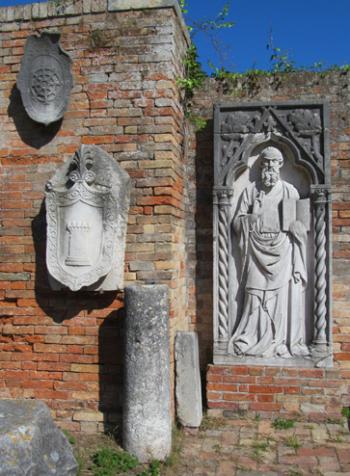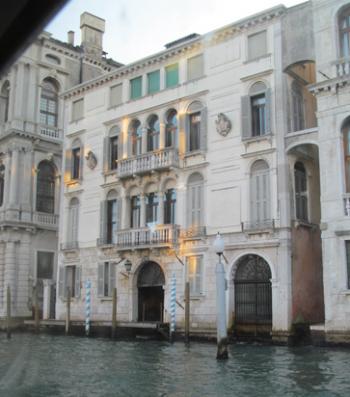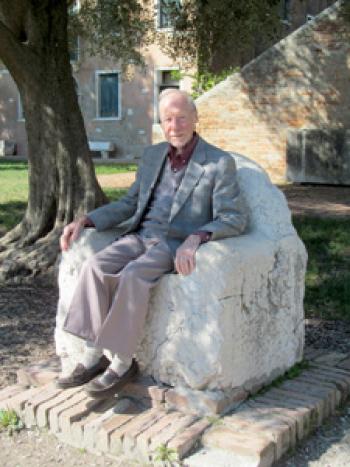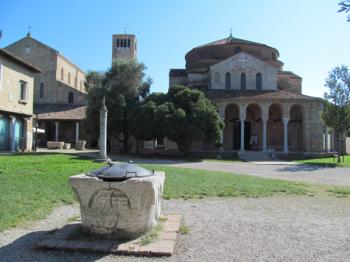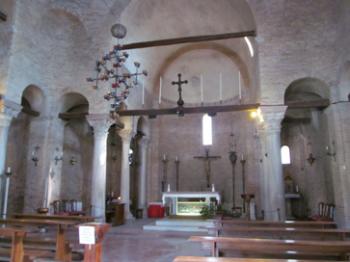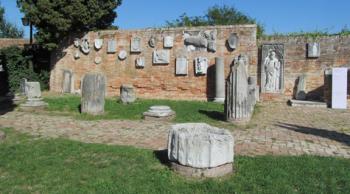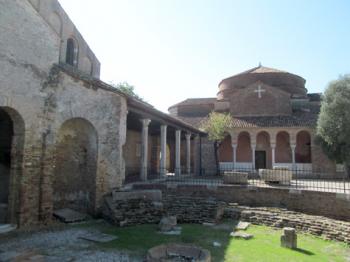Back to Torcello
This item appears on page 55 of the September 2017 issue.
On almost every one of my many trips to Venice, Italy, over the years, I have been drawn to the small island of Torcello. Situated in the Venetian Lagoon about 6 miles northeast of Venice, Torcello acts like a magnet. The more crowded Venice becomes, the more I am drawn to Torcello.
On my latest trip to Venice, for five weeks in September-October 2016, I needed Torcello more than ever. Though I love Venice — as does my husband, Paul — at some point midway through our trip, we needed less of Venice rather than more, and that’s exactly where Torcello fit in.
Torcello offers only itself: a grassy island of reeds and a few trees crossed by just one canal. Very few shops, restaurants or places to stay. No crowds.
Torcello’s origins
Torcello was not always this way. In the 5th century AD, as the Roman Empire was falling apart, barbarians began to pour in. Some of the coastal communities along the rim of the Venetian Lagoon decided to move to the lagoon islands for greater safety. One such community was Altinum, which, around AD 638, moved itself and its cathedral to the island of Torcello.
For approximately 700 years, Torcello grew and prospered, eventually reaching a population of about 20,000. There were churches, palaces, docks and the modest homes of its inhabitants.
Almost all of this is gone now, having succumbed to the growth of nearby Venice and to the scourge of malaria. By the 18th century Torcello was all but deserted. Today few live on the island, which, to me, is its appeal. Torcello is my escape from Venice when Venice begins to overwhelm.
From the boat landing on Torcello, the Fondamenta dei Borgognoni, the path beside the canal, winds its way to a green open space a 15-minute stroll away. Here are found a few of the island’s earliest structures, almost all that’s left of the once-thriving city.
Byzantine cathedral
The space is dominated by two churches. The Byzantine-style Cathedral of Santa Maria Assunta, originally transported to Torcello from Altinum nearly 1,400 years ago, was reconstructed in 1008. But the circular baptistry, now in ruins in front of the cathedral’s western entrance, dates from the earliest 7th-century church. Steps lead down to the central baptismal basin, which is, appropriately, often filled with rainwater.
Inside, the oldest part of the cathedral is the main altar, dating from the 7th century AD. It rests on an even older Roman sarcophagus brought from Altinum and said to be that of Heliodorus, Altinum’s first bishop.
Not to be missed are the black, red and white mosaic pavement, the marble pulpit and the stone benches in the apse intended for church officials, with a throne for the bishop set in the middle.
Magnificent mosaics
The highlight of the cathedral are the mosaics, especially the one in the main apse behind the stone benches that dates from the 12th and 13th centuries. It depicts the Virgin holding the Christ Child.
Even more magnificent is the 12th/13th-century mosaic filling the entire west wall of the church. It shows in graphic detail the Last Judgment and is filled with angels, devils, Apostles, the saved and the damned. These last are vividly portrayed in their torments: the lustful devoured by flames, the gluttonous gnawing at their own hands.
Next door to the cathedral is the 11th/12th-century octagonal Church of Santa Fosca, with a wooden dome and an exterior portico. Nearby are several palazzi now used as museums plus sculptural fragments from Torcello’s earliest days displayed picturesquely on an outside wall.
Nearby is Attila’s Throne, the large stone chair that Attila the Hun probably never sat on but which almost every tourist has (we never miss the chance, since we think it ensures a return to Torcello; so far, it’s worked).
Best about this remote lagoon island is its serenity, the feeling of having stepped back in time to before Venice was even thought of, to a time when foreign invaders forced the coastal community of Altinum to move to Torcello, making it their home.
Dining on Torcello
Paul and I suggest adding a special place to dine on Torcello to your experience of this unique island.
The Locanda Cipriani (Piazza Santa Fosca 29, 30142 Torcello, Venezia; Phone 39 041 730150, www.locandacipriani.com) is located five minutes from the cathedral and Santa Fosca. It is one of the best restaurants we have eaten in in more than a dozen trips to Venice and Torcello. The food is divine — pricey but worth it.
Our lunch for two, with pre-lunch drinks, appetizers, two glasses of Veneto wine, main courses, dessert and espresso, cost €211 (near $241) including tip.
The setting is equally divine. It was a lovely, mild, mid-October afternoon, and we chose to eat outside beside the Locanda’s flower garden. We could not have asked for a more perfect ending to our Torcello day — sipping Proseccos, with the two Torcello churches just beyond the Locanda’s garden.
Reservations are recommended, although you could luck out if you just happen to drop by. To be sure, we reserved a month in advance.
If you go…
There are several ways to get to Torcello. You can take a private water taxi (very expensive). Or you can take a vaporetto (water bus) from either the Fondamenta Nuove on the north side of Venice or from the Riva degli Schiavoni near Piazza San Marco.
Most water buses stop first at the island of Burano. We found a water bus, No. 12, that traveled directly to Torcello in about 50 minutes from the Riva degli Schiavoni. Schedules change, so it’s best to check in advance (actv.avmspa.it/en). Allow at least two hours on Torcello or double that if lunching at Locanda Cipriani.
Our home in Venice for five weeks in September-October was an apartment, the Rezzonico Suite, in the 16th-century palazzo Bernardo Nani, right on the Grand Canal. Our living room windows were practically at water level, giving us prime spectator seats for life on the canal.
The palazzo, located in Dorsoduro next door to Ca’Rezzonico, one of Venice’s major art museums, has a magnificent garden that renters of the apartment can stroll in or sit in.
We rented through Truly Venice (phone 41 614 110022, www.truly-venice.com), a Swiss company offering a wide selection of apartments in Venice. Our one-bedroom, one-bathroom apartment cost €5,040 ($5,985) for a 33-day rental.

